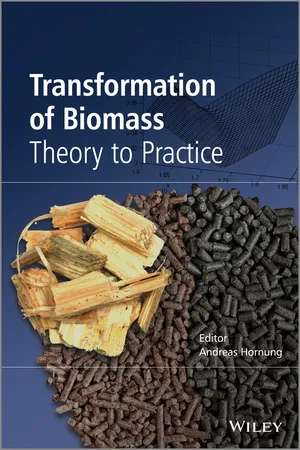
- English
- ePUB (mobile friendly)
- Available on iOS & Android
About This Book
Biomass is a key resource for meeting the energy and material demands of mankind in the future. As a result, businesses and technologies are developing around biomass processing and its applications.
Transformation of Biomass: Theory to Practice explores the modern applications of biomass and bio-based residues for the generation of energy, heat and chemical products. The first chapter presents readers with a broad overview of biomass and its composition, conversion routes and products. The following chapters deal with specific technologies, including anaerobic digestion, pyrolysis and gasification, as well as hydrothermal and supercritical conversion. Each chapter details current practises, recent developments, business case models and comprehensive analysis of the problems associated with each approach, and how to optimize them.
Topics covered include:
- Anaerobic digestion
- Reactor design
- Pyrolysis
- Catalysis in biomass transformation
- Engines for combined heat and power
- Influence of feedstocks on performance and products
- Bio-hydrogen from biomass
- Analysis of bio-oils
- Numerical simulation and formal kinetic parameters evaluation
- Business case development
This textbook will provide students, researchers and industry professionals with a practical and accessible guide to the essential skills required to advance in the field of bioenergy.
Frequently asked questions
1
Biomass, Conversion Routes and Products – An Overview
1.1 Introduction
| Name of country | Land area (million ha) | Forest area (million ha) | % | Forest area per 1000 people |
| Africa | 2965 | 674 | 23 | 683 |
| South America | 1756 | 864 | 49 | 2246 |
| North and Central America | 2110 | 705 | 33 | 1315 |
| Asia | 3094 | 593 | 19 | 145 |
| Europe | 2214 | 1005 | 45 | 1373 |
| Oceania | 849 | 191 | 23 | 5478 |
| Caribbean | 23 | 7 | 30 | 166 |
| World | 13010 | 4033 | 31 | 597 |
Table of contents
- Cover
- Titlepage
- Copyright
- About the Editor
- List of Contributors
- Preface
- Chapter 1: Biomass, Conversion Routes and Products – An Overview
- Chapter 2: Anaerobic Digestion
- Chapter 3: Reactor Design and Its Impact on Performance and Products
- Chapter 4: Pyrolysis
- Chapter 5: Catalysis in Biomass Transformation
- Chapter 5.A: Catalytic Reforming of Brewers Spent Grain
- Chapter 6: Thermochemical Conversion of Biomass
- Chapter 7:
- Chapter 8:
- Chapter 9:
- Chapter 10: Influence of Feedstocks on Performance and Products of Processes
- Chapter 11:
- Chapter 12:
- Chapter 13:
- Chapter 14:
- Chapter 15:
- Chapter 16:
- Chapter 17:
- Index
- End User License Agreement